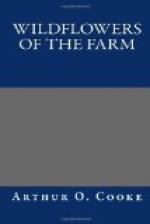Almost all plants, including large trees, have flowers—they are flowering plants. Just a few plants have no flower; ferns have none, nor have the mosses and lichens which grow on walls and rocks and on the stems of trees. Fungi, too, such as the mushroom, have no flowers. Nearly all other plants have flowers. It is by the flower or blossom that a plant is reproduced. After the flower has faded comes the fruit and seed; the seed falls into the ground or is sown, and from it springs another plant. Without the flower there would be no seed.
You see that there are rather more flowers than you had thought. Still, while we are strolling in the fields and lanes at Willow Farm, we shall look most at what are generally called flowers; we shall look at comparatively small plants in which the flower or blossom is easily noticed because it is large, or bright-coloured, or sweet-scented. But while we are admiring a Daisy or a Dandelion in the spring, we must not forget that the great Oak-tree above it also has a flower of its own—we must remember that the Oak-tree also is a flowering plant.
CHAPTER II
IN THE COPPICE
Outside the front door of Willow Farm is a broad curving gravel drive, at the far end of which a white gate opens into the lane. On one side of this drive is a narrow strip of ground planted with flowers and shrubs, and close to the front door there is a patch of grass on which stands a large old mulberry tree.
On the other side of the drive is a lawn. Beyond that are more flowers and then the vegetable garden; further on still is a little wood or coppice of nut bushes. On this March morning we shall find some wild flowers in this little wood.
Between the vegetable garden and the wood is a low grassy bank. It is bright to-day with yellow primroses. The Primrose always blossoms early here, for the bank is sunny and is sheltered from cold winds.
[Illustration: Primrose.]
I daresay most of you have seen a Primrose before to-day. Each pale yellow blossom is made up of five petals, which are joined together forming a tube or corolla. The petals are notched or indented on the outer edge. At the centre of the blossom, where the petals meet, each petal is marked with a spot of darker yellow. Each flower grows alone on a long slender stem. At the top of the stem is a kind of green tube out of which the yellow blossom appears. The Primrose blossoms have a scent; not strong, but very sweet and pleasant.
The leaves are called “radical” or “root” leaves. They are so called because each leaf appears to grow direct from the root. But the leaves really grow from a short stem at the top of the root—a stem so short that it does not appear above the ground at all.




